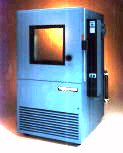Testing Disciplines
Temperature
| Typical temperature tests are conducted to evaluate short term effects of temperature on: | |
| Typical temperature tests are not considered practical for evaluating time-dependent degradation (aging) where synergetic effects may be involved. Long term effects are evaluated using accelerated aging tests where the material characteristics are taken into consideration. | |
| Relative humidity (RH) control during temperature tests is normally not necessary. Only in special cases, where extremely low humidity may have a significant effect on the materiel, should humidity be considered. High humidity conditions are a different test. | |
| Short Term Effects | |
| General Temperature Test Considerations | |
| When defining a test consider: | |
| Storage Test Purpose | |
| The storage test is used to investigate the effect of high or low temperatures on materiel or equipment during storage. The test item is exposed to high and low temperatures that may be encountered during normal storage followed by a performance test at the intended high and low operating temperatures. | |
| The number of cycles for the storage test is generally set at a minimum of seven to coincide with the one percent frequency of occurrence of the hours of extreme temperatures during the most severe month in an average year at the most severe location. When considering extended storage, critical materials, or materials determined to be very sensitive to high or low temperature, the number of cycles should be increased to assure the design requirements are met. | |
| Operation Test Purpose | |
| The operation test procedure is used to investigate the effect of high and low temperatures on the materiel or equipment performance while it is operating. For establishing the test item operating procedure, use the following guidelines. | |
| Typically there are two ways to perform operational tests, either with cyclic or constant temperature tests. | |
| Cyclic Conditions | |
| Determine the test duration based on the number of cycles required to satisfy the design requirements. Generally, the minimum number of cycles for operational exposure is three. This is normally sufficient for the test item to reach its maximum or minimum response temperature. When consistent temperature response is difficult to obtain, testing is frequently extended to a maximum of seven cycles. During cyclic temperature testing, test item thermal stabilization may not occur. | |
| During cyclic conditions the test item, at each temperature extreme, may be operated either continuously or periodically. | |
| Constant Temperature | |
| Expose the test item to the temperature condition until thermal stabilization occurs. Stabilization is determined by monitoring the test item temperature with thermocouples. Thermal stabilization is generally defined as a change in specimen temperature of less than 2° C in a one hour period. Once thermal stabilization is achieved, the temperature should be maintained for at least two hours. | |
| Determining Test Temperatures | |
| When selecting test temperatures identify the appropriate conditions for the areas in which the materiel will be operated and stored including: | |
| Test Item Configuration | |
| The test item configuration is based on the anticipated configuration(s) of the materiel or equipment for storage and operation. As a minimum, consider the following configurations: | |
| Storage | Operating |
| Test Apparatus | |
 The test apparatus
consists of a chamber or cabinet together with auxiliary
instrumentation capable of maintaining and monitoring the
conditions of temperature (and humidity, where required)
throughout an envelope of air surrounding the test item
as well as the test item temperature itself. As a general
rule the rate of temperature change. should not exceed 3° C per minute to prevent thermal
shock. The test apparatus
consists of a chamber or cabinet together with auxiliary
instrumentation capable of maintaining and monitoring the
conditions of temperature (and humidity, where required)
throughout an envelope of air surrounding the test item
as well as the test item temperature itself. As a general
rule the rate of temperature change. should not exceed 3° C per minute to prevent thermal
shock. |
|
HOW CAN WE HELP?
Whether you're looking for a standard test or have a unique testing problem,
we can help. We have the experience that you can rely on and the creativity
to solve your problem.



